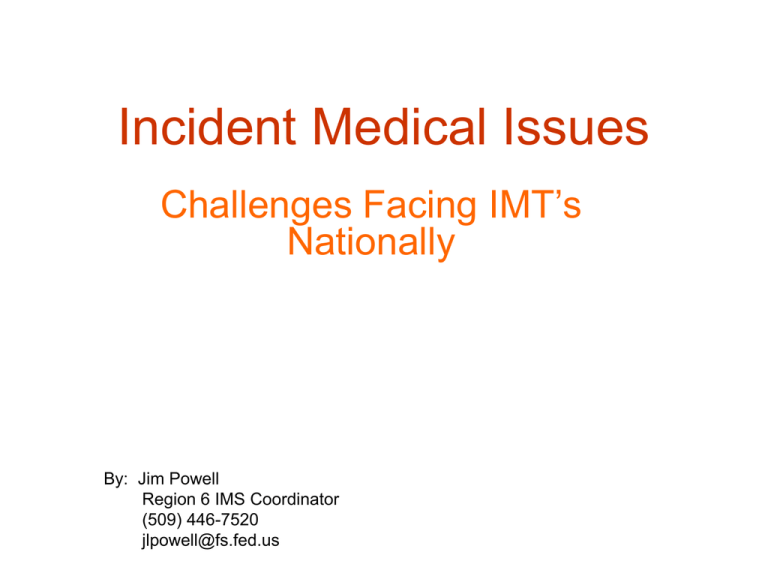Incident Medical Issues Challenges Facing IMT’s Nationally By: Jim Powell
advertisement

Incident Medical Issues Challenges Facing IMT’s Nationally By: Jim Powell Region 6 IMS Coordinator (509) 446-7520 jlpowell@fs.fed.us EMT’s and IMS Crossing State Lines • Currently, Pacific Northwest and Rocky Mountain IMS have Protocols and approval to work on any FEDERAL Incident nationally. These must be incidents of Federal jurisdiction i.e., Forest Service, BLM, NPS, Tribal Lands, etc. • On Non-Federal incidents EMS and IMS must contact the State DOH or presiding EMS Director and be granted permission to operate. • Alaska is very advanced in this process allowing reciprocity for the period of time you are assigned to an incident. • Montana has been a challenge, and currently will only let out of State EMS to practice at the Basic EMT Level, limiting our ability to provide quality treatment at levels of certification. Some other States also have issues i.e., Washington GEO Board won’t permit IMS to practice on State jurisdiction. The EMSG is working with all states to standardize acceptance of Certification Levels. EMS vs. IMS • Limitations of Contract EMS Services: – Unable to perform outside of their State and local Protocols. Some MPD’s don’t support them out of their areas. – Can legally only treat Serious Illness and or Traumatic Injuries and transport, not normally treat and release. – Cannot perform Clinical Triage and/or administer Over-TheCounter (OTC) medications i.e., Aspirin, Ibuprofen, Cough drops, Eye drops, feminine hygiene products, Moleskin, etc. to incident personnel. – Must obtain definitive medical care for everyone that seeks their help. – High cost with Low use potential. Only treat acute illness and/or trauma. – Contract services may be all that is available and then should be used. – Limited qualified Contract services may be available i.e., Wilderness Medics, Inc., Paramedics Unlimited. These resources are limited and usually specific to a geographical area. EMS vs. IMS (cont.) • Standards of IMS Services: – EMT’s at various levels highly trained in clinical diagnostics and pharmacology. – Have a Physician Advisor with established Clinical Protocols, operating under his license. – Training and Protocols to dispense OTC medications. – Ability to triage out patients not needing definitive medical care. – Line qualified personnel for placement at various locations on incident. – Skilled in Helicopter Medi-vacs and wilderness care and rescue. – Highly cost effective, even with annual pre-season training costs and equipment maintenance. Cost Containment EMS vs. IMS • Regional contract cost for ALS Ambulance with 1 EMTP and 1 EMTB, usually NOT Line Qualified personnel = $2400/day on average. • Approx. Daily cost for IMS Team of 1-2 EMTP’s, 1-4 EMTI’s, and/or 1-2 EMTB’s for a total of 6 personnel with at least 4 being Line Qualified = $2150/day. • Usually 1 IMS Team can sufficiently staff an incident and the Medical Unit, providing ALS coverage 24/7 on site. Sometimes additional IMST’s are requested for large complex incidents with multiple access points and Branches to provide adequate line coverage. Availability or Not of AED’s (Defibrilators) • It has been difficult if not impossible to obtain AED’s and/or Defibrilators on Fire and All Risk assignments. • Buying Teams will usually not obtain or pursue this issue, and cancel orders. • Manufacturers are unwilling to rent AED’s and/or Defibrilators any longer. • Private companies i.e., Ambulance services, Fire Depts, etc. charge very high rates for rentals. Devices could usually be purchased for what it costs to rent them if you can find any to rent at all. • Bottom Line is we have been Lucky to date. We will eventually have a fatality due to not having this equipment available on incidents. This will likely be one of our own!!!!!! This is due to our aging workforce, and their general health in a high stress related situation. Availability or Not of AED’s (Cont.) (Defibrilators) • What is our responsibility and liability to our workforce? Shouldn’t we provide them the best available care we can, and are trained to provide? • Doesn’t OSHA clearly state that all employees have the right to work in a safe environment? Are we doing whatever possible to provide such an environment? • To the best of our knowledge we have not been tested in court, but OSHA states an employer should provide appropriate firstaid on remote sites. Not just someone trained in CPR but appropriate equipment also i.e., Defibrilators or AED’s. • What can we do to address the problems and get them fixed? • Documented save last year on Sexton’s Type I Team. Contract Crews • What Medical Services are we going to provide? • Do we transport to Medical Facilities and/or off the line? • Emergency Life Saving care will be administered regardless and then sorted out by finance. Patient Privacy Issues • All pertinent patient information is confidential and will be kept as such unless a release is signed by the Patient. • Patient Evaluations will be sent to their Home Unit with their CA-1 or CA-2. Copies will not be kept in the Fire Packet due to sensitivity of information. Other Issues and Concerns • What other issues and/or concerns are there in the Medical arena? • How can we fix what is broken, or not working as well as it could? • Other? Thank You !!! • Your participation in this Break-out session is greatly appreciated.

